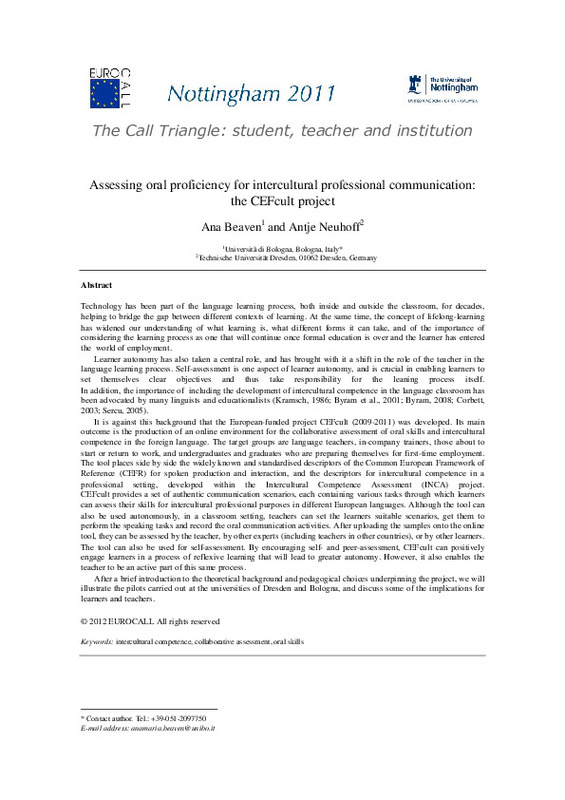JavaScript is disabled for your browser. Some features of this site may not work without it.
Buscar en RiuNet
Listar
Mi cuenta
Estadísticas
Ayuda RiuNet
Admin. UPV
Assessing oral proficiency for intercultural professional communication: the CEFcult project
Mostrar el registro sencillo del ítem
Ficheros en el ítem
| dc.contributor.author | Beaven, Ana
|
es_ES |
| dc.contributor.author | Neuhoff, Antje
|
es_ES |
| dc.date.accessioned | 2023-11-22T08:25:01Z | |
| dc.date.available | 2023-11-22T08:25:01Z | |
| dc.date.issued | 2012-03-22 | |
| dc.identifier.uri | http://hdl.handle.net/10251/200067 | |
| dc.description.abstract | [EN] Technology has been part of the language learning process, both inside and outside the classroom, for decades, helping to bridge the gap between different contexts of learning. At the same time, the concept of lifelong-learning has widened our understanding of what learning is, what different forms it can take, and of the importance of considering the learning process as one that will continue once formal education is over and the learner has entered the world of employment. Learner autonomy has also taken a central role, and has brought with it a shift in the role of the teacher in the language learning process. Self-assessment is one aspect of learner autonomy, and is crucial in enabling learners to set themselves clear objectives and thus take responsibility for the leaning process itself. In addition, the importance of including the development of intercultural competence in the language classroom has been advocated by many linguists and educationalists (Kramsch, 1986; Byram et al., 2001; Byram, 2008; Corbett, 2003; Sercu, 2005). It is against this background that the European-funded project CEFcult (2009-2011) was developed. Its main outcome is the production of an online environment for the collaborative assessment of oral skills and intercultural competence in the foreign language. The target groups are language teachers, in-company trainers, those about to start or return to work, and undergraduates and graduates who are preparing themselves for first-time employment. The tool places side by side the widely known and standardised descriptors of the Common European Framework of Reference (CEFR) for spoken production and interaction, and the descriptors for intercultural competence in a professional setting, developed within the Intercultural Competence Assessment (INCA) project. CEFcult provides a set of authentic communication scenarios, each containing various tasks through which learners can assess their skills for intercultural professional purposes in different European languages. Although the tool can also be used autonomously, in a classroom setting, teachers can set the learners suitable scenarios, get them to perform the speaking tasks and record the oral communication activities. After uploading the samples onto the online tool, they can be assessed by the teacher, by other experts (including teachers in other countries), or by other learners. The tool can also be used for self-assessment. By encouraging self- and peer-assessment, CEFcult can positively engage learners in a process of reflexive learning that will lead to greater autonomy. However, it also enables the teacher to be an active part of this same process. After a brief introduction to the theoretical background and pedagogical choices underpinning the project, we will illustrate the pilots carried out at the universities of Dresden and Bologna, and discuss some of the implications for learners and teachers. | es_ES |
| dc.language | Inglés | es_ES |
| dc.publisher | Universitat Politècnica de València | es_ES |
| dc.relation.ispartof | The EuroCALL Review | es_ES |
| dc.rights | Reconocimiento - No comercial - Sin obra derivada (by-nc-nd) | es_ES |
| dc.subject | Intercultural competence | es_ES |
| dc.subject | Collaborative assessment | es_ES |
| dc.subject | Oral skills | es_ES |
| dc.title | Assessing oral proficiency for intercultural professional communication: the CEFcult project | es_ES |
| dc.type | Artículo | es_ES |
| dc.identifier.doi | 10.4995/eurocall.2012.16034 | |
| dc.rights.accessRights | Abierto | es_ES |
| dc.description.bibliographicCitation | Beaven, A.; Neuhoff, A. (2012). Assessing oral proficiency for intercultural professional communication: the CEFcult project. The EuroCALL Review. 20(1):27-30. https://doi.org/10.4995/eurocall.2012.16034 | es_ES |
| dc.description.accrualMethod | OJS | es_ES |
| dc.relation.publisherversion | https://doi.org/10.4995/eurocall.2012.16034 | es_ES |
| dc.description.upvformatpinicio | 27 | es_ES |
| dc.description.upvformatpfin | 30 | es_ES |
| dc.type.version | info:eu-repo/semantics/publishedVersion | es_ES |
| dc.description.volume | 20 | es_ES |
| dc.description.issue | 1 | es_ES |
| dc.identifier.eissn | 1695-2618 | |
| dc.relation.pasarela | OJS\16034 | es_ES |








